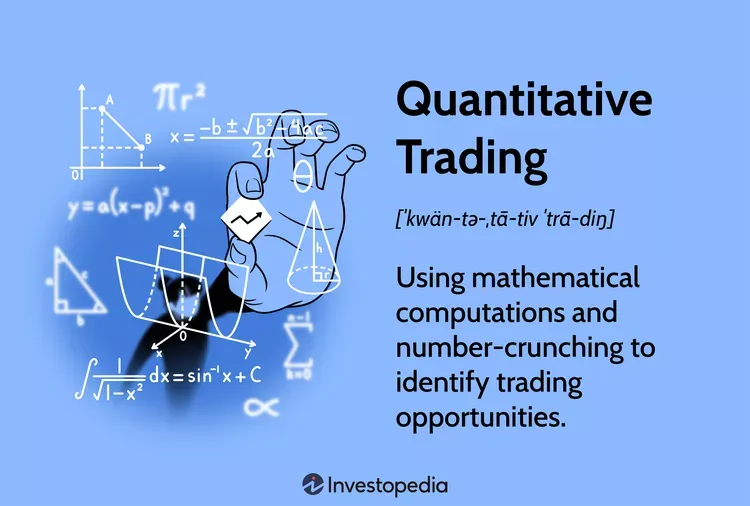by Rohith Iyer
Published On Jan. 20, 2025
The integration of technology, data, and mathematical models has revolutionized investing, giving rise to quantitative investing or "quant investing." While using analytics and algorithms may seem daunting for beginners, there are quantitative strategies that allow beginners to step into the investing scene. These quantitative strategies also help in making the investing process a lot easier, allowing one to approach this in an efficient manner (Coresignal 2022).
In quantitative investing, data and underlying trends inform which trades are made, rather than just relying on intuition as would occur with other traditional methods. Moreover, even for a person with no experience in trading, quant strategies such as momentum investing, mean reversion, and index tracking make it easy to participate in the financial markets. This guide attempts to provide a more thorough understanding of quantitative investing by explaining basic strategies and tools, which were specifically designed for those wishing to delve deeper into this innovative field.
Quantitative investing uses data, statistics, and algorithms to guide investment decisions.It provides an organized and systematic way of assessing and analyzing the behavior and conditions the market is in. The traditional methods of making investment decisions often involve considerable uncertainty and reliance on subjective intuition. Quantitative investment, on the other hand, relies on verified facts, which minimizes the risk of errors or distortion caused by emotional bias.
Core Benefits for Beginners:
Removes Emotional Bias: Decisions are based on data, ensuring that fear or greed does not cloud the judgment or impairs decision making.
Structured Evaluation: Provides a clear framework for assessing investments.
Data-Driven Opportunities: Assesses the historical or real-time data in order to make informed decisions.
The simple techniques are the best starting points for beginners as they use strategies such as momentum which detects the upward trend, or mean reversion strategies that look for undervalued assets whereby the price is expected to stabilize gradually over time. The more advanced concepts are built upon these strategies, so beginners can gain a foundation using these strategies.

(Sharma, Anderson & Rosenston 2024)
By adopting certain assets like stocks, ETFs or other securities that show short-term positive trends and momentum, it will be possible to maximize returns. The stochastic oscillator is a technical indicator that guides an analyst in identifying trends along with the moving averages, for instance the 50 and 200 day moving averages (Murphy, Anderson & Kvilhaug 2023).
Identify Momentum: By adopting certain assets like stocks, ETFs or other securities that show short-term positive trends and momentum, it will be possible to maximize returns. The stochastic oscillator is a technical indicator that guides an analyst in identifying trends along with the moving averages, for instance the 50 and 200 day moving averages.
Determine Time Frame: Momentum strategies cover a short-to-medium performance period of three to six months.
Rebalance Regularly: An active strategy that involves frequently checking and adjusting the portfolio, ensuring that the strong performing assets remain in circulation while excluding underperforming ones (González 2024).
A beginner could use platforms like Yahoo Finance or Google Finance to analyze historical stock performance and identify stocks trending upward. After finding which stocks are gaining momentum they can further use tools such as relative strength indicators to create a shortlist of high-performing assets.
For instance:
Use a 50-day moving average to track short-term momentum and compare it to the 200-day moving average for longer-term trends.
Identify stocks where the short-term average crosses above the long-term average, signaling potential upward momentum.
Mean reversion strategies work by buying assets below the historical mean under the assumption that their price will rise back to the mean and selling or shorting the assets above the mean with expectation that market inefficiencies and investor overreactions create opportunities for buying undervalued assets and selling overvalued ones (Archer 2023).
Identify Historical Averages: Analyze the historical price range or average of an asset, using tools like Bollinger Bands or simple moving averages to visualize deviations.
Spot Deviations: Look for assets trading significantly above or below their historical mean. Prices above the mean may indicate overvaluation, while prices below the mean suggest undervaluation.
Trade Based on Reversion: Buy assets below their historical mean with the expectation they will rise back to the average, and sell or short assets above the mean, anticipating a decline.
For instance, let's say the historical and average trading price of Stock ABC was approximately $100, however, it dropped to $90 recently. In this case, the mean-reversion strategy recommends buying Stock ABC as there is an expectation that the price will climb back toward $100.
To apply this:
Use Bollinger Bands to identify when an asset’s price moves outside its normal range (two standard deviations from the mean).
Combine this with historical data to confirm the asset typically reverts to its average over time.
The simplest definition of index tracking would be a quantitative strategy where an investor uses algorithms or other quantitative tools to replicate the performance of specific market indices such as the S&P 500. The advantage of this process is that it is a low cost investment strategy because it seeks to replicate the performance of the said index (Sant’Anna, Caldeira & Filomena 2019).
Simplicity: No necessity to have a deep understanding of individual securities , as the strategy focuses on tracking an entire index.
Broad Diversification: the risk gets spread across multiple securities belonging to that index.
Cost Efficiency: This framework is very affordable for beginners, primarily through index-tracking ETFs since the fees paid are quite low for transactions and portfolio management.
Select an Index: Pick a market index that you would want to keep tabs on, for instance S&P 500, NASDAQ and any index of your choosing.
Invest in Tracking Tools: Use exchange-traded funds (ETFs) or mutual funds designed to mimic the index’s performance.
Leverage Automation: Various platforms provide index automation investment tools, so you never have to worry about straying too far from the chosen market index.
Check out Vanguard, iShares, or Fidelity that provide a variety of index tracking exchange-traded funds (ETFs).
Invest in an ETF that performs and closely matches with the index you would want to track.
Automate investments through recurring contributions, ensuring consistent exposure to the index over time.

(Quant Investing 2024)
For someone who is interested in quantitative investing as a beginner, it can be implemented using easily comprehensible and precise methods of investing. These strategies are aimed towards the people new to the world of finance, making it a good fit for the beginners. Here are some key benefits:
Beginner quant strategies rely on simple, well-defined rules that are easy to understand and apply, even for those with limited financial or technical expertise.
Clear Frameworks: Strategies such as momentum investing or index tracking come with step-by-step processes that are intuitive and do not require much customising.
User-Friendly Tools: Platforms like Yahoo Finance, Google Finance, and ETF trackers provide ready-to-use tools that simplify execution.
Quantitative strategies prioritize data and logic, creating a structured approach to investing that minimizes emotional interference.
Reduced Emotional Bias: By relying on algorithms or predefined rules, these strategies limit impulsive decisions driven by fear or greed.
Objectivity: Investments are based on measurable criteria, ensuring a consistent and disciplined approach to portfolio management.
Many beginner strategies can be implemented with a lower initial investment, making them affordable to a wide range of investors.
Affordable Entry: There are strategies, such as index tracking or mean reversion using ETFs, that require only a small investment to begin while achieving diversification.
Scalable Options: Beginners can scale up their investments over time as they gain confidence and resources.
Beginner strategies serve as a stepping stone for understanding the fundamentals of quantitative investing.
Hands-On Experience: Application provides a more significant understanding of financial data, analytical tools and some of the basic tools.
Foundation for Growth: These strategies provide a solid base for exploring more advanced quantitative techniques in the future.
Because most beginner strategies minimize trading fees and management costs, investors are able to retain a greater amount of investment capital.
Passive Management: Strategies like index tracking are more passive in character meaning that there is less people needed to work to implement the strategy and so there are even less costs involved.
Low Fixed Cost: Most of the tools and platforms that are used in the beginner strategies are either free or very cheap.
All those who are starting out in the financial market find it a little hard to believe but find it easy to use beginner friendly quantitative strategies which are quite seamless to integrate. These strategies in addition to providing instant returns help lay a robust foundation which can be built on later in future (Marketfeed Team 2024).
If you are preparing to venture into quantitative investing, you will need some strong software and online platforms to conduct analysis, strategy tests, and trading with ease (Radovanovic 2020). Here are the most essential tools for beginners:
Without the availability of valid and sufficient data, it will be difficult to devise any kind of quantitative strategy.
Yahoo Finance: This is a simple interface platform geared at historical stock prices, financial statements, and market trends.
Bloomberg: an industry-level data provider that includes comprehensive analysis of the market and provides professional-grade features.
Quandl: This is an all in one platform that allows users easy access to financial, economic, and various other datasets, with the additional feature of APIs for integration with Python or R.
With the help of the backtest tools, it is possible for users to evaluate the efficiency of their strategies by testing them using historical data.
QuantConnect: Some advanced automation tools for coding, testing and deploying algorithms including those made with Python or C# are available here.
AlgoTrader: This is one of the complex platforms that are designed for automated trading and strategy development. It is great for people who want to investigate automated trading.
TradingView: A beginner-friendly option as it has a good integration of charting and strategy testing tools.
Programming improves ability to perform data analysis and build custom-made strategies.
Python: A widely-used programming language with libraries like Pandas (data manipulation) and NumPy (numerical analysis).
R: A programming language for statistics which can be used by researchers involved in quantitative business for developing visual models.
Beginners often face challenges when starting their quantitative investing journey. If you desire a favorable outcome, make sure to avoid the mistakes listed below:
Mistake: Testing strategies with inadequate historical data can lead to unreliable results.
Solution: Ensure that the datasets you use span over multiple cycles so that when you analyze the market, you will be able to be aware of the performance during various market conditions.
Mistake: Beginners sometimes create overly complex models that are hard to execute or understand.
Solution: Focus on simple, clear rules that you can easily apply and adjust as needed.
Mistake: Ignoring fees, spreads, and any other costs in the business when trading on a high frequency can be a huge mistake, which can significantly reduce profitability.
Solution: Factor in all trading costs when designing and backtesting strategies.
Mistake: Ignoring risk exposes you to the possibility of suffering from huge unnecessary losses.
Solution: Prevent drawbacks by using stop-loss orders, having limited position sizes or even diversifying your portfolio.
John, a novice investor employs a momentum strategy whilst focusing on the IT sector. After analyzing the IT stocks that performed exceptionally well over the past few months, he then goes ahead to invest in the stocks with consistent growth. He rebalances his portfolio quarterly to maintain momentum exposure, achieving steady annual returns.
Sarah notes that a popular ETF is trading 10% lower than its historical average. As this represents a mean-reversion opportunity, she makes a small investment in the ETF. The price of the ETF appreciates up to the historical mean price with time and she makes a profitable return on the investment.
Emily incorporates index tracking in her investment strategy in order to make it easier to understand. She purchases an S&P 500 ETF. This strategy gives her broad market exposure, guaranteed returns, and little effort managing individual shares, which works perfectly for her busy schedule.
These examples demonstrate how beginner-friendly quant strategies can be effectively applied in real-life scenarios, offering both simplicity and potential for long-term growth.

(Tata Capital 2024)
Quantitative investing makes use of an investor’s knowledge and skills and offers a data-centered structured investment that’s ideal for beginners. New investors can engage confidently in the markets through momentum investing, mean reversion, and index tracking by employing simple and effective strategies. Such strategies make it easier for a novice investor to invest, as they provide an even working basis of critical thinking, which is wholly data driven, unlike traditional investment methods that rely on intuition.
What makes quantitative investing easy is the fact that it’s based on rules and plenty of readily available tools, which helps even the most inexperienced investors succeed. Also, a beginner can benefit from financial data, backtesting, and algorithmic tools to improve their strategies in the long run. On top of this, avoiding common mistakes, such as limited data, overcomplicating a strategy, and neglecting risk management help investors amplify the likelihood of being able to generate steady returns with minimal losses.
You don’t need to be a specialist or an institutional investor anymore to engage in quantitative investing. With the right materials and tools, as well as a measure of discipline, the opportunity to secure long-term returns is available to anyone. What is essential for a better start is for beginning investors to gradually build confidence and competence, by starting off slowly and applying what they have learnt, and then progressively moving onto more advanced methods. Quantitative investing gives people the ability to shape their investment opportunities in the manner best suited to the individual investor, providing them with the possibility to foster and grow in a systematic way.
Momentum investing is one of the easiest strategies, as it involves identifying and investing in top-performing assets over a specific period.
While coding skills are not mandatory, learning basic Python or R can enhance your ability to analyze data and backtest strategies.
You can start with as little as $500, especially when using low-cost ETFs or fractional shares.
Yes, many platforms like TradingView and QuantConnect offer beginner-friendly interfaces and tutorials for backtesting strategies.
Yes, strategies like index tracking are well-suited for long-term wealth accumulation.
Discover investment portfolios that are designed for maximum returns at low risk.
Learn how we choose the right asset mix for your risk profile across all market conditions.
Get weekly market insights and facts right in your inbox
It depicts the actual and verifiable returns generated by the portfolios of SEBI registered entities. Live performance does not include any backtested data or claim and does not guarantee future returns.
By proceeding, you understand that investments are subjected to market risks and agree that returns shown on the platform were not used as an advertisement or promotion to influence your investment decisions.
"I was drawn to Wright Research due to its multi-factor approach. Their Balanced MFT is an excellent product."

By Prashant Sharma
CTO, Zydus
By signing up, you agree to our Terms and Privacy Policy
"I was drawn to Wright Research due to its multi-factor approach. Their Balanced MFT is an excellent product."

By Prashant Sharma
CTO, Zydus
Skip Password
By signing up, you agree to our Terms and Privacy Policy
"I was drawn to Wright Research due to its multi-factor approach. Their Balanced MFT is an excellent product."

By Prashant Sharma
CTO, Zydus
"I was drawn to Wright Research due to its multi-factor approach. Their Balanced MFT is an excellent product."

By Prashant Sharma
CTO, Zydus
Log in with Password →
By logging in, you agree to our Terms and Privacy Policy
"I was drawn to Wright Research due to its multi-factor approach. Their Balanced MFT is an excellent product."

By Prashant Sharma
CTO, Zydus
Log in with OTP →
By logging in, you agree to our Terms and Privacy Policy
"I was drawn to Wright Research due to its multi-factor approach. Their Balanced MFT is an excellent product."

By Prashant Sharma
CTO, Zydus
Answer these questions to get a personalized portfolio or skip to see trending portfolios.
Answer these questions to get a personalized portfolio or skip to see trending portfolios.
(You can choose multiple options)
Answer these questions to get a personalized portfolio or skip to see trending portfolios.
Answer these questions to get a personalized portfolio or skip to see trending portfolios.
Answer these questions to get a personalized portfolio or skip to see trending portfolios.
(You can choose multiple options)
Investor Profile Score
We've tailored Portfolio Management services for your profile.
View Recommended Portfolios Restart